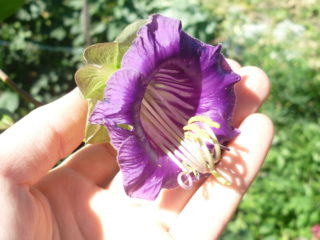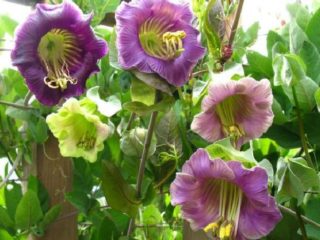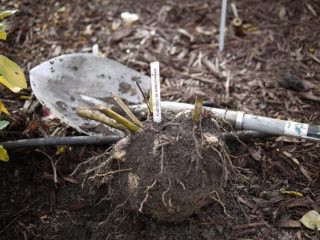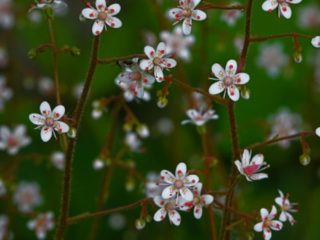Content
Kobeya is a climbing plant belonging to the Sinyukhovye family. The homeland of vines is the South American tropics and subtropics. Thanks to its beautiful flowers, it is cultivated in many countries and is actively used in landscape design. Planting and caring for a kobe in the open field in temperate latitudes has its own characteristics.
General description of kobei
In natural conditions, nine species of vines grow. Cultivated kobei climbing.
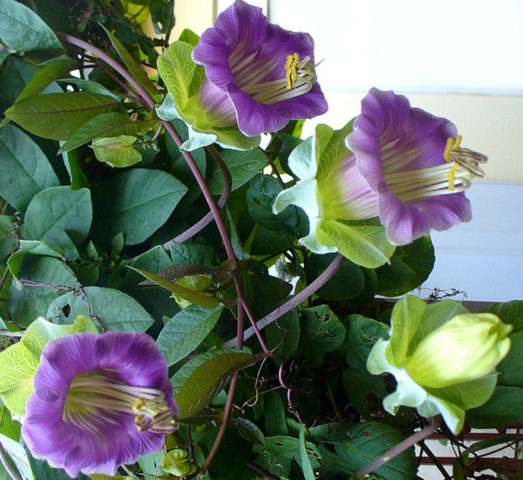
Large spectacular bells do not leave indifferent the owners of garden plots
The plant has a long, tenacious stem that grows up to 6 m in length, and in some species of liana - more than 6 m. It has a large number of antennae.
The kobei has complex feathery leaves, consisting of three lobes. On a long petiole, one can see paired oval-shaped leaves with short petioles and pronounced veins. One of the same is located at the top of a long petiole. At the end of the shoot, the leaves take the form of tendrils, with which the plant clings to the support.
The large flowers of the kobei are bell-shaped. They emerge from the axils of leaves on short peduncles, reach a diameter of 8 cm and differ in a variety of shades: they can be white, cream, purple. Vine flowers grow singly or in groups.
Kobei fruit is a leathery capsule with oval seeds.
The root system of the plant is powerful, highly branched, with many fibrous thin roots.
A characteristic feature of the vine is very fast growth. Within a short time, it covers quite large areas with lush greenery.
In the tropics, kobei is a perennial plant, in Russia it is cultivated as an annual.
Kobei in landscape design
Liana is ideal for decorating and landscaping the garden. It allows landscape designers to bring creative ideas to life.
The plant is used to create hedges, vertical gardening of arbors, arches and pergolas, balconies.
Kobei can be planted in volumetric stable containers and placed around the perimeter of the recreation area.
Liana allows you to hide the flaws of architecture: an ugly brick wall, a dilapidated fence.
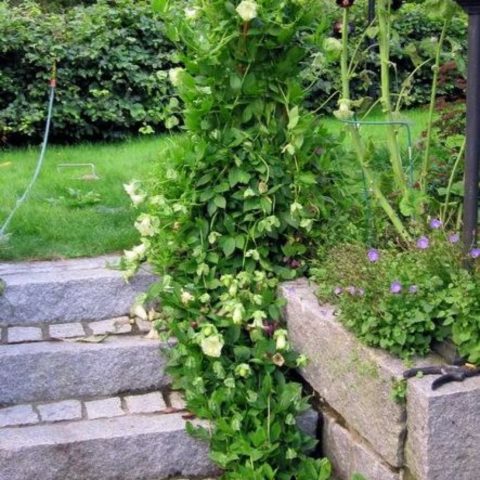
Kobeya grows not only upward: it can be planted on the last rung of a ladder in a container and directed downward.
With the help of a dense wall, which forms a liana, you can divide the site into zones.
The wire frame will turn into a green shape if only one plant is planted.
In flower beds, liana is planted along with petunia, marigolds, lobelia, verbena.
You can see what a kobei looks like in landscape design - in the photo below.
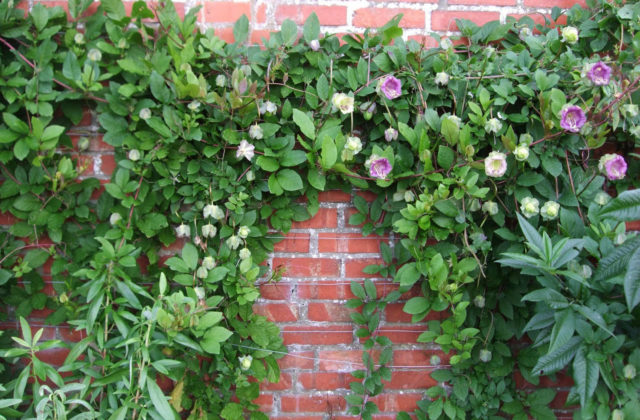
A creeping plant with beautiful flowers looks good against a brickwork background
Breeding features
There are several ways to breed kobei: by seeds, cuttings, layering. In our conditions, as a rule, the first one is practiced.
It is not possible to plant vine seeds directly into the ground in areas with a temperate climate. For growing kobei in the Moscow region, the seedling method is used. Seeds are germinated indoors in individual containers with the ground, as soon as warm weather sets in, the seedlings are transferred to open ground to a permanent place.
For reproduction, kobei are cut into strong young shoots from plants that have spent the winter in containers. Cuttings should be about 20 cm long and 3 pairs of leaves.With the onset of warmth, they are rooted in the open air in a shaded place in damp ground. It is believed that a kobe, propagated by cuttings, grows faster.
Another way is to drop layers. In an adult liana, they find an shoot located as close to the ground as possible, lay it in a long dug groove, sprinkle it with soil, and leave a slightly pinched top on the surface. The ground around the kobei is constantly moisturized. After a while, young shoots germinate from the cuttings.
Planting kobei in the ground
You can buy kobei seedlings or grow them yourself. It is believed that the second method is preferable, since when growing seedlings in large quantities for sale, there is no way to create the most favorable conditions for them.
Timing
Kobei is transplanted into the ground at the end of spring and beginning of summer. More precise timing depends on the climate. Typically, this is the period from mid-May to mid-July. The main thing is that at this time warm weather is established without the risk of night frosts.
Site selection and soil preparation
First of all, it must be borne in mind that this plant is decorative and should be planted where it is clearly visible.
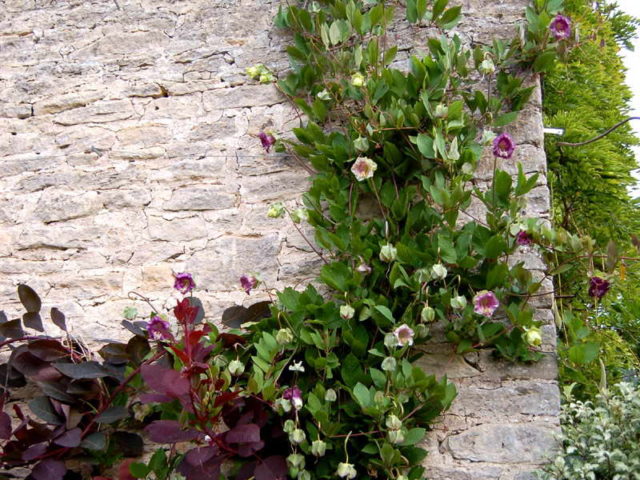
A windless warm place with good illumination is suitable for creepers, but not in the sun
The soil for growing kobei should be fertile, rather loose, and easily permeable to water. The land at the planting site must be dug up and the following components must be added per 1 sq. m:
- half a bucket of sand;
- humus bucket;
- a bucket of peat.
In addition, the soil needs to be fertilized: for each plot of 1 sq. m it is necessary to add 40 g of urea or urea. Planting holes should be spacious and filled with fertile soil.
Landing algorithm
Before planting, kobei need to grow seedlings from seeds. The process is not too easy, but fun. It consists of pre-sowing preparation of the material, germination, sowing in the soil mixture and obtaining seedlings. This is followed by transplanting vines into the ground in the garden.
Sowing seeds
The time of planting kobei seeds for seedlings falls on the end of February - beginning of March. The preliminary preparation of the seed takes 2-3 days. It takes about 2 weeks to germinate vine seeds.
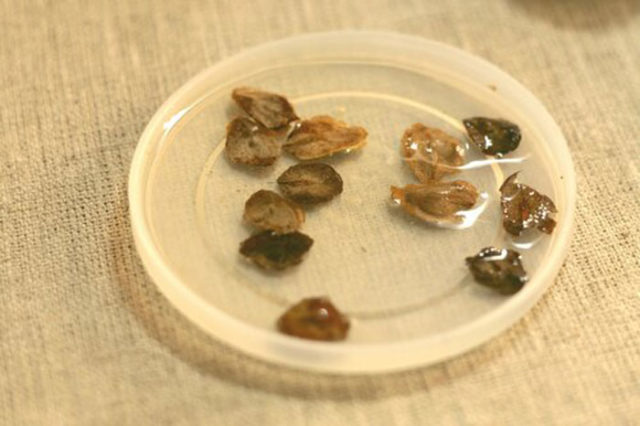
Plant seeds have a hard shell and do not germinate well, so they need pre-sowing preparation
Kobei seed preparation consists of the following steps:
- Soak. For an hour, the seed must be held in a growth stimulator. It can be prepared from equal amounts of aloe juice with honey, or from 5 drops of zircon, 4 epin and 100 ml of water.
- Germination. After soaking, the kobei seeds must be dried in the fresh air, laid out on a moistened gauze folded in several layers so that they do not touch each other, covered with a film, and sent to a warm, shaded place. Check periodically. If a plaque or mold is found on the seeds, they must be wiped with a napkin soaked in a weak solution of potassium permanganate. They should germinate after about 14 days.
For sowing kobei, containers are needed:
- Individual cups, pots, peat tablets.
- Containers or boxes approximately 15 cm deep. They should have multiple drainage holes in the bottom.
- Cylinders made of several layers of foil to be placed in a tray with holes in the bottom and filled with earth.
To prepare a substrate for a vine, you will need the following components:
- 2 parts of garden soil;
- 4 parts of the land is sheet;
- 2 parts of humus;
- 1 part coarse sand.
The soil for the kobei should be loose and light.
This is followed by planting the seed:
- Fill the selected containers with prepared earth.
- Place the sprouted kobei seeds on top of the potting mix with the convex side up.If they are planted in common containers, the distance between them is 20 cm.
- Sift the substrate and cover the seeds with a layer of 1.5 cm.
- Moisten the earth using a spray bottle.
- Place in a warm, well-lit place. Avoid direct sunlight. Moisten the earth periodically.
After about 2-3 weeks, the kobei seeds will sprout. After the appearance of the first leaf, they, together with a lump of earth, dive into individual pots, the volume of which should be approximately 3 liters. In a room with seedlings, it is necessary to maintain high air humidity by spraying. A month after the pick, pinch the tops of the plants. 3 weeks before planting, they begin to harden the seedlings, gradually accustoming them to open air.
Transplanting
Planting kobei in open ground is carried out according to the following rules:
- Dig holes at a distance of about 0.8 m. The depth should be such that the roots of the plant do not bend.
- Potted kobei seedlings should be well watered.
- Remove the vine seedlings from the containers along with a lump of earth. The plastic containers must be cut open and carefully removed.
- Place each kobei bush vertically in the hole, cover the roots with earth.
- Water the plant with a fine mesh watering can.
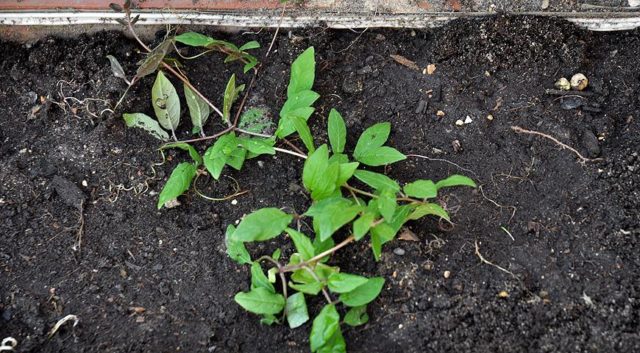
For a vine seedling, you need to install a support immediately after planting.
How to raise a kobei
It is necessary to take proper care of the kobe: follow the irrigation and fertilization schedule. It is important to loosen and weed, inspect for diseases and pests.
Watering and feeding schedule
Liana does not need too much watering. Water should be poured not under the roots, but between the bushes. In hot summer, the kobei needs to be watered more often, but care must be taken so that the land does not become waterlogged.
Fertilizer begins to be applied in the second week after transplanting the plant into open ground. Kobei is fed twice a month. For active growth of green mass, at first, nitrogen-containing fertilizers are mainly applied. As soon as the buds appear and the vines begin to bloom, you need to switch to compositions with a high content of potassium and phosphorus.
Weeding and loosening
Liana kobei needs systematic loosening of the soil. As weeds appear in the ground around the plant, weeding should be done.
Wintering
The heat-loving kobea is not able to hibernate in the open field in an area with a temperate climate.
If it is necessary to preserve the plant, it will have to be dug out of the ground and transplanted into a container so that it hibernates indoors.
You need to proceed as follows:
- Before the arrival of frost, cut off the ground part of the vines at a level of about 30-40 cm from the soil surface.
- Dig up the root with a clod of earth.
- Prepare a container with fertile soil mixture and plant the kobei.
- Place the plant for the winter in a cool darkened room with a temperature of 5-8 degrees.
- Check the kobei rhizome periodically. To prevent drying out, the soil must be regularly moistened.
In March, move the container with the vine to a warm room. It is necessary to provide the plant with watering so that the shoots grow.
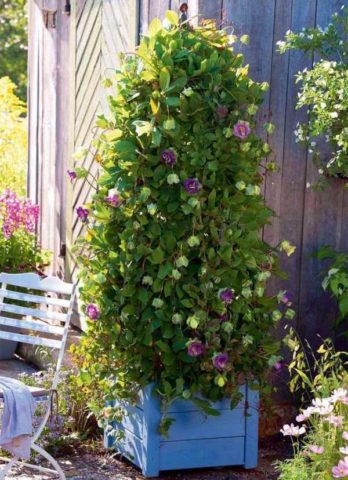
The plant will delight with its flowering appearance, subject to full care.
Pests and diseases
Of the diseases, root rot affects the kobei. It poses a great danger to the plant. Signs of the disease - dark spots on the leaves and flowers, further wilting of the vine. Typically, root rot appears when the soil is humid.
In hot climates, phenomena such as slow growth of kobei, drying out of the tips of the leaves can be observed. Therefore, the plant must be sprayed in the evening.
Of the pests, the kobei is affected by aphids and spider mites.
Aphids can be fought with folk remedies or chemicals. The second way is more efficient.
A spider mite, which is often noticed too late, when the leaves have already begun to turn yellow and crumble, or a cobweb has appeared on flowers and leaves, is of particular danger for the cobei. The disease quickly spreads to neighboring plants; in advanced cases, the vine dies.Therefore, it is necessary to regularly carefully examine the kobei, preferably with a magnifying glass, and not only the surface of the leaves, but also the reverse side. There you can see small insects, many eggs and a light cobweb. It is quite difficult to fight this pest. Its female produces several hundred eggs in a short life of 2 weeks, which remain in the ground for up to 5 years. Affected kobei leaves must be torn off and burned, and the plant treated with chemicals, which are recommended to be changed all the time due to the insect's adaptability.
Conclusion
Planting and caring for a kobe in the open field is not an easy task. Not every gardener succeeds in propagating a plant the first time. Subject to all the rules, the result will be positive and a magnificent vine will become a decoration of the summer cottage.
